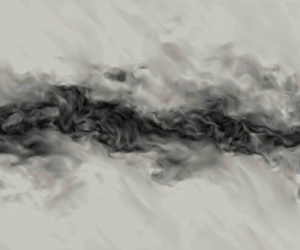Published online by Cambridge University Press: 02 July 2021

The present article investigates the effects of a BZT (Bethe–Zel'dovich–Thompson) dense gas (FC-70) on the development of turbulent compressible mixing layers at three different convective Mach numbers  $M_c=0.1$, 1.1 and 2.2. This study extends a previous analysis conducted at
$M_c=0.1$, 1.1 and 2.2. This study extends a previous analysis conducted at  $M_c=1.1$ (Vadrot et al., J. Fluid Mech., vol. 893, 2020) Several three-dimensional direct numerical simulations (DNS) of compressible mixing layers are performed with FC-70 using the fifth-order Martin–Hou thermodynamic equation of state (EoS) and air using the perfect gas EoS. After having carefully defined self-similar periods using the temporal evolution of the integrated streamwise production term, the evolutions of the mixing layer growth rate as a function of the convective Mach number are compared between perfect gas and dense gas flows. Results show major differences for the momentum thickness growth rate at
$M_c=1.1$ (Vadrot et al., J. Fluid Mech., vol. 893, 2020) Several three-dimensional direct numerical simulations (DNS) of compressible mixing layers are performed with FC-70 using the fifth-order Martin–Hou thermodynamic equation of state (EoS) and air using the perfect gas EoS. After having carefully defined self-similar periods using the temporal evolution of the integrated streamwise production term, the evolutions of the mixing layer growth rate as a function of the convective Mach number are compared between perfect gas and dense gas flows. Results show major differences for the momentum thickness growth rate at  $M_c=2.2$. The well-known compressibility-related decrease of the momentum thickness growth rate is reduced in the dense gas. Fluctuating thermodynamics quantities are strongly modified. In particular, temperature variations are suppressed, leading to an almost isothermal evolution. The small scales dynamics is also influenced by dense gas effects, which calls for a specific sub-grid-scale model when computing dense gas flows using large eddy simulation. Additional dense gas DNS are performed at three other initial thermodynamic operating points. DNS performed outside and inside the BZT inversion region do not show major differences. BZT effects themselves therefore only have a small impact on the mixing layer growth.
$M_c=2.2$. The well-known compressibility-related decrease of the momentum thickness growth rate is reduced in the dense gas. Fluctuating thermodynamics quantities are strongly modified. In particular, temperature variations are suppressed, leading to an almost isothermal evolution. The small scales dynamics is also influenced by dense gas effects, which calls for a specific sub-grid-scale model when computing dense gas flows using large eddy simulation. Additional dense gas DNS are performed at three other initial thermodynamic operating points. DNS performed outside and inside the BZT inversion region do not show major differences. BZT effects themselves therefore only have a small impact on the mixing layer growth.